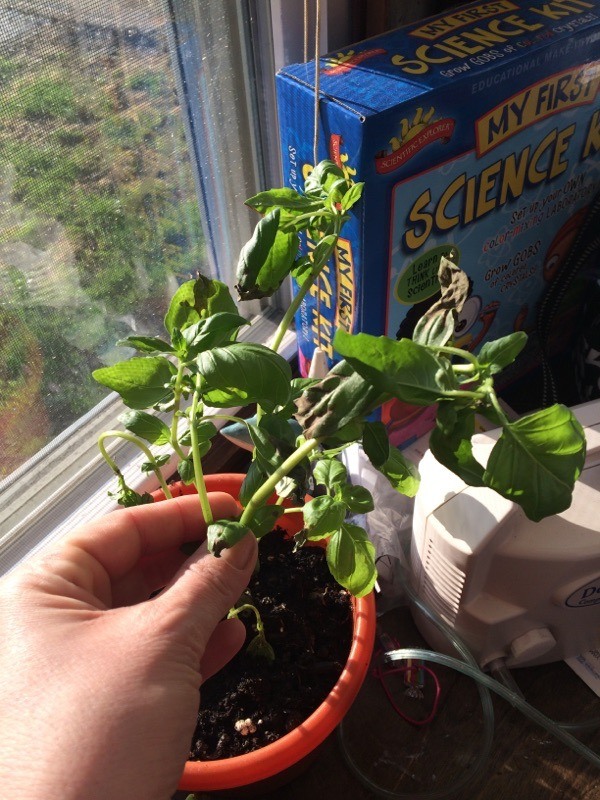Basil plants are my favorite kitchen herbs for cooking. The herb is suitable for adding flavors and nutrients to the food. But growing and maintaining vibrant basil foliages at home can be a daunting experience for season growers.
So, why are my basil leaves curling? Basil leaves curling down are due to improper sunlight exposure, inappropriate watering routine, pest infestations, temperature stress, low humidity, and plant diseases.
Continue reading this article to know the reasons behind the basil leaves turning yellow and curling. The information will also help you identify the exact cause and its respective solution to avoid future occurrences.

Causes and Solutions of Basil Leaves Curling
Improper Sunlight Exposure
Basil thrives under full or indirect sunlight for six to eight hours. It can also endure four hours of direct sunlight when other growing conditions are optimal.
Indoor basils should be grown near a north-facing window and outdoor counterparts in full sunlight. Insufficient natural light makes the basil leaves curl and turn yellow.
Low light also causes leggy stems and small leaves formation. If you’re growing indoor basils in a dark room, install artificial lights to mimic its natural habitat. (Source: RHS).
Overwatering Stress
Basil plants prefer slightly moist potting soil to stay healthy and happy. A damp environment increases the risk of root rot that inhibits the roots from undertaking their physiological activities.
Damaged roots due to root rot are unable to absorb water and vital minerals. Basil leaves turning yellow and curling are initial symptoms of root rot.
The golden rule is to inspect the soil moisture content by inserting an index finger in the 2-3 inches of the topsoil. Soak the potting mix if the soil is completely dry.
I recommend watering basil plants more often during spring and summer. Remember to reduce the watering frequency in winter due to the low transpiration rate.
Under-watering Problem
Basil plants cannot survive in drought conditions. You’ll notice the basil leaves curling and drooping due to dehydration.
Underwatered basil is bitter with an unpleasant scent. I recommend watering the herb to boost soil moisture content and rehydrate the plant.
If the drought situation persists for an extended period, the basil is likely to wilt and die. Develop a strict watering routine to keep your basil plants healthy and happy.
Pest Infestations
Basil plants are fairly resistant to insect infestations. But it does imply that these herbs are invincible when it comes to pest attacks.
The red spider mites, aphids, thrips, and scales are the leading insects affecting basil plants. They suck juices from leaves and damage vital tissues.
Basil leaves curling and turning yellow are clear signs of insect infestation. Be sure to examine the underside of the leaves to confirm the presence of insects.
Use insecticidal oils or soap to treat leaves affected by these sap-sucking creatures. Ladybugs are the best predators for getting rid of insects from basil plants.
Plant Diseases
Basil plants are more vulnerable to fusarium plant disease. The fungal condition makes the basil leaves curl and turn brown in the long run.
I recommend the use of fungicide to treat the damping-off condition. Fusarium and verticillium wilt are more lethal since they cannot be treated. (Source: North Carolina State University)
The golden rule is to avoid overwatering to reduce the risk of fungal growth. Be sure to plant the basils with adequate space to encourage airflow.
Temperature Stress
Basil plants are sensitive to sudden temperature changes. Extreme cold, frosts, and drafts cause deformed basil leaves.
Prolong exposure to cold drafts can result in basil leaves curling and turning brown. It also inhibits the formation of new growths.
Basil herbs thrive in a temperature range of 65-85oF. Any temperature below 50oF results in small leaves formation or basil leaves turning brown.
Lack of Humidity
Basils are tropical plants that do best in a warm and humid environment. Dry air-condition around the basil plants causes leaves to curl and even droop.
I recommend misting the basil leaves when the air around the plant is dry. Another excellent option is to use a humidifier for indoor basils to boost humidity levels.
Ensure the indoor humidity level is above 50% and the room is well-ventilated. Improper airflow with high humidity increases the risk of fungal growth.
Root Bound
Basil plants are fast-growing and tend to have large root systems at maturity. These roots may need adequate space to avoid plant suffocation.
The root-bound issue occurs when the roots grow through the drainage holes and experience curly leaves. The best solution is to repot the basil to a larger pot.
Be sure to use well-draining potting soil and organic matter to boost its fertility. You’ll notice basil leaves curling before the plant acclimates to the new potting soil.
Frequently Asked Questions
Do Basil Plants Need a Lot of Water?
Basils love to stay in moist soil that never gets soggy. Soak the soil more often to enable the roots to grow deep and in relatively moist areas. Do not overwater your basil plant.
Why Are My Basil Leaves so Small?
Indoor basils receiving insufficient natural light are vulnerable to small leaves. The best option is to consider growing your basil plants outside to promote large leaves development.
Can You Eat Curled Basil Leaves?
Yes. But ensure all the curled regions are clean before cooking it. Most curl basil leaves tend to hide some bugs that might ruin your food flavors.
Conclusion
Basil plants are a little bit challenging to grow and maintain at home. The herb is more vulnerable to pests and diseases that ruin its vibrant foliages.
Basil leaves curling are due to pest infestation, improper sunlight exposure, fungal diseases, inappropriate watering routine, and temperature stress.
I hope the information in this article will help you figure out the reasons behind basil leaves curling and turning yellow or brown. Let us know your views in the comment section.
